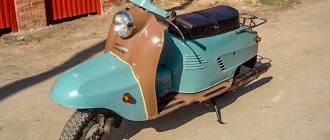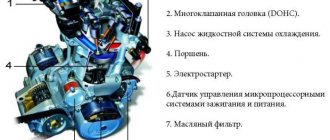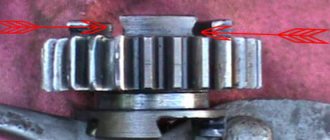In Soviet times, a fairly large number of motor vehicles were produced. Among them were motor scooters. Here you can recall such models as Tula, Tulitsa, Ant, Vyatka and many others.
A fairly interesting and popular domestic (Soviet) scooter at one time was the Vyatka. Moreover, it was produced in several modifications. The most recent of them was Vyatka-3 Electron. The technique received its name due to the fact that for the first time in the Soviet Union an electronic ignition system was used. This explains the prefix to the name Vyatka.
Many will be interested in learning about this scooter, as well as getting acquainted with its technical and operational characteristics.
Power point
The engine of the Vyatka scooter is a single-cylinder, two-stroke, and has the following characteristics:
- Working volume – 148 cubic cm.
- Compression ratio – 6.7.
- Cylinder diameter – 57 mm.
- Power – 5.5 l. With.
- The piston stroke is 58 mm.
- Torque – 3800 rpm.
The ignition of the Vyatka scooter is a contact magneto with manual adjustment of the gap and spark advance. The spark plugs used were standard A16 motorcycle spark plugs. This ignition system had one significant drawback: the constant high voltage caused the contacts to burn. A depression, the so-called “cavity,” developed in one tungsten plate, and a tubercle formed on the other contact plate during engine operation, which had to be periodically cleaned off.
The carburetor of the Vyatka scooter is a diffuser with one jet of limited range. The damper was driven by a cable from the right rotating steering wheel handle. Fuel entered the carburetor by gravity from the gas tank located under the seat. The tap, located at the bottom of the tank, was connected to the carburetor with a flexible hose made of gasoline-resistant rubber. The diameter of the hose clearance is sufficient for the unhindered supply of fuel. The fuel supply could be shut off by turning the tap handle. The carburetor was equipped with a special rod on the float chamber cover, designed to submerge the float before starting the engine in cold weather. When the rod was pressed, a free flow of gasoline opened, the mixture became richer, and the engine started.
The design of the chassis is a welded frame combined with a supporting stamped body. The body of a convenient layout allowed the driver to sit behind the wheel with sufficient comfort. The Vyatka scooter was ideal for those who didn’t want to drive fast. The two-seater seat easily accommodated both driver and passenger. Behind the seat there was a small luggage rack on which you could place a bag with things or some small cargo. Below the trunk, a brake light was mounted, and even lower, a bracket with a license plate. And this whole “ensemble” was completed by a rubber mudguard with the embossed inscription “VPMZ,” the abbreviation of the manufacturing plant.
Scooter owners noted such a significant drawback as overheating of the motor. The engine's location did not allow air to circulate to the extent needed for efficient cooling. In addition, the engine niche was tightly closed with casings on both sides. On the left side there is a stationary round-shaped trunk, and on the right side there is a removable casing that covers all the engine mechanisms. Longitudinal grooves were cut into this cap, designed to provide access to air masses, but they were not enough. Many scooter drivers removed the right cover to open up access to oncoming air flow, but such actions were stopped by the traffic police.
Ignition of the chainsaw. Device, circuits, malfunctions.
The ignition system of a chainsaw is a whole complex of elements with the help of which a spark appears when the engine starts. It is needed in order to ignite the fuel and bring the engine into a state of full long-term operation. The main element of the ignition system is the spark plug, which must be ignited whenever the engine is in the desired operating cycle. And although the system is reliable and well thought out, sometimes it requires repair, so the user needs to know how his chainsaw works, as well as what he can do to repair its ignition system.
Three-wheeled modifications
In the fall of 1959, at the exhibition “Motor scooters and motorcycles”, held at the Moscow Polytechnic Museum, various three-wheeled versions of the “Vyatka” were presented. The engine on all models was located in the middle, rotation was transmitted to the rear wheels through a bevel differential, and then to the rear drive wheels.
The Vyatka scooter in this version was widely used in the field of grocery delivery around the city. A total of three variants were produced: the MG-150F model, with a closed body, the MG-150 with an open platform, and the MG-150S with a dump body. All modifications had a carrying capacity of 250 kilograms. The speed of movement did not exceed 35 km/h.
A little history
Licensed, modernized and even pirated versions produced all over the world have made the Italian scooter very popular. Vyatka manufacturers also could not resist the temptation to use Vespa as the base model for the first Soviet scooter. They did not make a complete copy for fear of claims from Italy, but used the basic parameters.
So in 1957 the “Vyatka-150” appeared, and in 1964 the modification “Vyatka-150VP” was created, which differed from the previous version in an extended base, a new body, and a modernized front fork. The rear suspension received a chain drive instead of the previous direct connection of the engine to the drive wheel.
"Vyatka" as a service transport
At the request of VDNKh, the plant developed the VP-150T motorcycle taxi model, where the two driving wheels were located in front and were steerable. In addition to the driver in the back, there were two people in the front seat. The miniature vehicle aroused keen interest among the public and was in demand among visitors to the National Economy Exhibition.
To ride a motorcycle taxi from one pavilion to another, many were even willing to wait in a short line. The fare was symbolic. The motorcycle taxi was especially pleasing to the children, who asked their parents to ride again and again. Yes, actually, mom and dad weren’t averse to taking a ride on such an unusual vehicle either.
The motorcycle taxi was produced in the amount of 50 copies.
"Vyatka-Electron"
In 1965, a new model was developed based on the Vyatka 150. The scooter was named “Vyatka-Electron”. It differed from its predecessor in a new body with less rounded contours, an elongated base, a front long-link fork and more compact shock absorbers. At the same time, the Vyatka-Electron scooter retained the engine in its original form, but boosted to a power of 6 hp. With. Due to the extended base, it was necessary to make an intermediate chain drive, which became part of the rear wishbone suspension. The chain drive was hermetically sealed to prevent dust or dirt from getting into it in rainy weather.
Serial production of the new model began in 1967, and the outdated Vyatka 150 scooter was discontinued in the same year. The new model immediately gained popularity among young people. Being the owner of a beautiful sparkling car was considered prestigious. The economical motor of the scooter worked silently, and full filling of the gas tank cost no more than one ruble.
In 1973, the Vyatka-Electron scooter was modernized, the engine power increased and amounted to 7 hp. s., while fuel consumption remained the same - 3.1 liters per 100 kilometers. The design of the case has changed. But the main and most spectacular result of the scooter’s restyling was the installation of electronic contactless ignition. In the USSR, this was the first time the promising device was used. However, every new product has its positive and negative sides. If the electronics failed, the owner of the scooter could not figure out the problem on his own and was forced to look for special services or a private specialist to troubleshoot the problem. Thus, the supposed advantage often turned into criticism. But in general, the Vyatka-Electron scooter was a popular means of transportation.
Magneto for walk-behind tractor
The principle of operation of a magneto on a walk-behind tractor is similar to an ignition coil - it is responsible for the appearance of a spark.
You can check the magneto of a walk-behind tractor as follows:
- The cap is removed from the top of the candle and a nail is inserted. All manipulations must be performed as carefully as possible so that after rechecking the spark plug can be re-installed in place;
- The nail is located seven millimeters from the cylinder of the unit;
- The spark plug is returned to its standard position and the walk-behind tractor engine is started;
- A spark should form during the start. At the same time, it will be strong, with a blue tint. If the spark is different, this indicates that the problem has not been resolved.
Declining popularity
Despite its innovative characteristics, the Vyatka-Electron scooter gradually began to lose demand. And by the end of the 70s, its sales dropped to almost zero. Overstocking began in warehouses, and stores massively refused new supplies. The drop in demand is explained by the fact that the population has the opportunity to purchase cars on a larger scale. Many people preferred to buy domestic motorcycles; moreover, at the end of the 60s, deliveries of the Czechoslovak “Java” began to the USSR, which created a real sensation among young people.
As a result of all these changes, the Vyatsko-Polyansky plant stopped production of the Vyatka-Electron scooter in August 1979. The history of such a vehicle ends here. And in the early 90s, after the collapse of the Soviet Union, the plant launched the production of the small “Strizh” scooter, copied from the German “Simson”.
How to Install the Ignition on a Chinese Chainsaw Video
A very class of chain saws for the unit use gasoline engines. They are certainly equipped with an ignition system, which is responsible for the timely ignition of the fuel-air mixture in the cylinders by means of an electronic discharge that breaks through the space between the electrodes of the spark plugs. How correctly you can choose the studio when the spark appears depends on the correct operation of the motor. Checking the technical condition of the resulting gasoline saw to allow for accounting (software) ignition should be given increased attention. In specialized stores, the equipment is sold in working order; if the setting turns out to be wrong, you can set the ignition on the chainsaw without the help of others.
The design and principle of operation of the chainsaw ignition system
The standard ignition system of a carburetor engine consists of:
- magneto;
- spark plugs;
- an electrical cable connecting them to each other;
- motor shutdown buttons.
Ignition circuit for the Ural chainsaw
A magneto is a type of alternator that supplies electrical energy to the spark plugs . It consists of a stationary winding of an inductance coil and a permanent magnet mounted on a flywheel that rotates with the crankshaft of a gasoline engine. The moving magnetic field creates an electromotive force in the low-voltage winding, which is converted by the transformer into a voltage with a potential sufficient to produce a spark.
For contact magnetos, the first terminal of the high-voltage winding is connected to the spark plug, and the second is connected to the ground through a mechanical switch. At a certain moment, a special design element separates the contacts, which leads to a sharp increase in voltage in the network and a spark in the interelectrode space of the spark plug.
To prevent overheating and oxidation of the breaker contacts, a capacitor is connected to the electrical circuit.
The ignition circuit of a chainsaw with a contactless magneto is based on the operation of a control coil, which plays the role of a voltage regulator. The electronic unit also includes a diode, a capacitor and a thyristor that passes current with a voltage of a certain value. When it opens, the capacitor is intensively discharged, forming a current in the turns of the primary winding, which is induced into a high-voltage voltage, causing a breakdown on the spark plug installed in the cylinder. The electrical network operates in pulse mode in time with the rotation of the crankshaft and the translational movement of the cylinders.
HOW TO SET THE IGNITION COIL CLEARANCE, chainsaw Partner, McCulloch, Jonsered, the magneto clearance
Video
talks about the ease of adjusting the magneto gap using the wall of a plastic bottle. Repair.
Ignition! Set the gap on the chainsaw. In one minute.
Allows you to correctly determine in a situation when disassembling and replacing the ignition
needs to be exposed.
Ignition timing
The mechanical device and factory installation of the magneto ensure that the discharge time of the spark plug coincides with the optimal position of the moving piston. For four-stroke gasoline engines, the spark must occur before the piston reaches top dead center - this is explained by the fact that the process of complete combustion of the air-fuel mixture takes a certain time. The speed of movement of engine parts is comparable to the speed of ignition of the fuel, so the piston has time to travel a certain distance from the moment the spark jumps to the moment the burning gases create extremely high pressure.
For each engine there is an ignition timing angle. It is equal to the crank rotation expressed in degrees from the moment of breakdown in the interelectrode space of the spark plug
until the piston reaches top dead center. This indicator depends on many parameters, including the design features of the engine and the properties of the fuel mixture.
In practice, during mass production of an engine at a factory, individual ignition adjustment of each product is not performed, but corresponding marks are placed on the rotating parts, which must be aligned during installation.
In what cases is ignition adjustment required? There are main symptoms of system failure:
- the engine does not start;
- the engine runs, but with noticeable interruptions;
- there is a decrease in tool power.
In these cases, you should not rush to contact the service center. Try adjusting the ignition yourself first.
Repair support for motor scooters
More than thirty-five years have passed since production. Almost all scooters of both modifications - both "Vyatka" and "Vyatka-Electron" - have long since been scrapped. However, a certain number of cars are still in the hands of antique connoisseurs and collectors. Rare specimens need repairs, which means they need spare parts. The Vyatka-Electron scooter has been preserved better than its predecessor, but it also needs restoration. Spare parts can still be found at used equipment junkyards or even in stores that sell repair kits for motorcycles and scooters.











